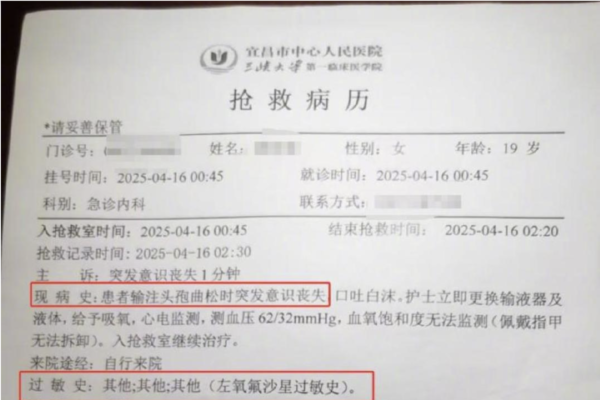A 19-year-old freshman at a university in Hubei province went to the emergency department of the West Ling Campus of the Central People’s Hospital in Yichang City, Hubei, due to abdominal pain. Within 4 minutes of receiving cephalosporin infusion, she exhibited abnormal reactions, without any medical staff present. Despite attempting self-removal of the needle, she quickly fainted. Ultimately, she succumbed to anaphylactic shock and acute respiratory failure.
According to a report by Dahe Daily on the evening of May 3, when interviewed, Mr. Tao, a family member of the patient, stated that Tao Lan (alias) is a freshman this year. Around 10:57 pm on April 15, she and three classmates went to the emergency department of the West Ling Campus of the Central People’s Hospital in Yichang due to abdominal pain. When asked by the doctor if she had any drug allergies, Tao Lan replied that she wasn’t sure. Subsequently, the doctor prescribed cephalosporin sodium for injection and other medications.
Family members indicated that later Tao Lan’s classmates informed them that she had asked the doctor if a skin test was needed before using cephalosporin, to which the doctor replied that it was unnecessary.
“Upon infusion of the second bag of liquid, which contained cephalosporin, she experienced discomfort within 4 minutes,” Mr. Tao said, noting that he watched the hospital’s surveillance video at the police station. At 11:23 pm on the 15th, Tao Lan began receiving intravenous fluids in a treatment room on the first floor. Around 12:35 am on the 16th, the nurse replaced Tao Lan’s medicine with cephalosporin, and then left. Tao Lan began feeling unwell around 12:39 am, while the classmates who accompanied her to seek medical treatment were either paying fees or picking up documents, coincidentally away from her side.
Family members stated that through surveillance footage, they saw Tao Lan calling out but found no medical staff around. In the infusion corridor, there were only a few scattered patients. Tao Lan resorted to removing the needle herself. Around 12:41 am, she knelt down and collapsed next to the infusion chair. A passing man noticed the abnormality and called for help, prompting medical staff to rush to the scene.
In the early hours of April 16, Tao Lan was transferred to the ICU for treatment.
The emergency medical record provided by the family showed that more than four hours before seeking medical attention, the patient experienced abdominal pain, vomiting, and diarrhea, along with fever and palpitations. Outpatient diagnosis indicated “abdominal pain, acute gastroenteritis.” She had a history of being allergic to levofloxacin.
Based on the patient’s condition, the doctor prescribed relevant treatment medications: intravenous cephalosporin sodium 2g each time; the analgesic drug tramadol hydrochloride injection 100mg intramuscularly each time; antiemetic and gastrointestinal regulatory drugs including metoclopramide hydrochloride injection and droperidol injection; in addition, basic intravenous fluids including glucose and saline solution, as well as nutritional supplements, were administered.
The rescue record showed that during the infusion of cephalosporin sodium, the patient suddenly lost consciousness and began vomiting white foam. Upon examination and assessment, the patient was diagnosed with anaphylactic shock and acute respiratory failure…
On April 20, despite rescue efforts, Tao Lan passed away. The death certificate cited the cause of death as anaphylactic shock and multiple organ failure.
The family questioned why a skin test was not conducted if there was a possibility of cephalosporin allergy. Given the risks associated with medication, why were there no medical staff observing the patient during the infusion?
The family urgently seeks answers – who should be held accountable for those fatal 4 minutes?
Cephalosporins, like penicillin commonly used in clinical practice, are one of the most familiar classes of antibiotics to the public. They belong to the β-lactam antibiotic group, known for strong bactericidal activity, low toxicity, wide indications, and good clinical efficacy, but also notable for the potential to trigger allergic reactions.
The focal point of contention between the patient’s family and the hospital lies in whether a skin test is necessary before using cephalosporin and whether medical personnel should observe the patient’s condition for a period after its use. The family questioned why no skin test was conducted on the deceased before the use of cephalosporin and why the nurse left after administering it, without providing care, leaving the patient to self-remove the needle when an allergic reaction occurred without any medical staff present.
On April 29, staff from the Medical-Patient Relations Department of the West Ling Campus of the Central People’s Hospital responded, stating that there was no issue with not conducting a skin test. There is no requirement mandating a skin test before using cephalosporin. Doctors and nurses need to treat multiple patients and not provide individual care, denying the absence of medical staff during the infusion.

